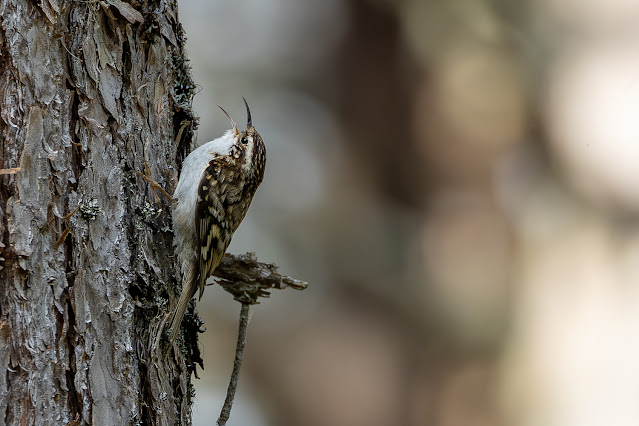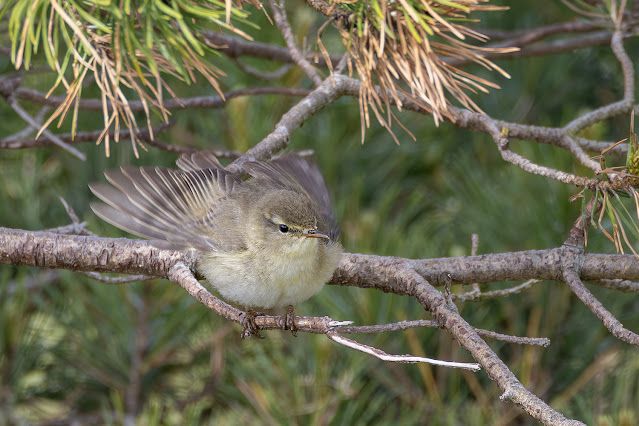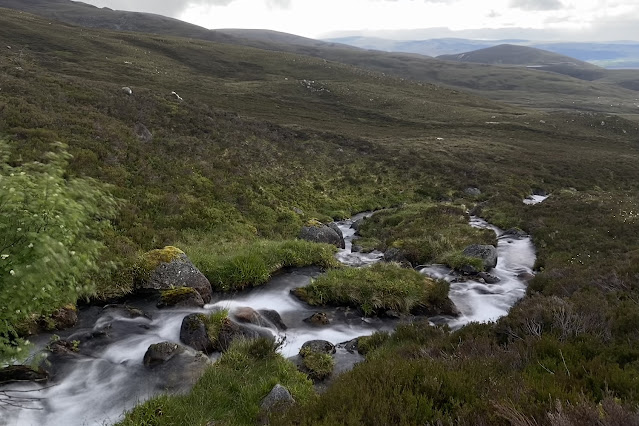During my limited time in the UK I have done a bit of birding here and there, last year with my friend John Hansford's help I added a few more species to my UK list, especially some of the southern specialties. I have however never birded up north except the one visit to Shetland many years ago, there were quite a few highland specialties missing on my life list. So, with a bit of planning, I drew up an itinerary that will include most of the birding hotspots around the highlands, and a few interesting birding spots that I thought would be worth visiting. Since Scotland is huge, my itinerary couldn't quite include the western isles or the Isle of Skye, or Isle of Mull in the matter of fact, those will have to wait for another visit in the future (Corn Crakes!). We flew out on the 29th of May, stayed a few days in London to visit family and friends and headed up Scotland on the 3rd of June together with my parents and Hoiling.
31st May - Rainham Marsh, London
This was my only proper morning I spent birding around London, I thought it was worth paying a visit to RSPB Rainham Marsh, as this is probably the best nature reserve London has to offer. Situated in East London, the site was previously used as a firing range for the military, it was converted into the nature reserve in the 2000s and opened to the public. The area was quite large, we sampled most of the core areas but did not visit the area further west closer to the landfill. The first birds we saw were numerous Common Whitethroats and a few Chiffchaffs singing away in the bushes, a few recently fledged Chiffchaffs were making begging calls to their parents for food.
 |
| Common Whitethroat |
 |
| Chiffchaff |
Towards Ken Barrett Hide we added a young Little Grebe that was very close to the hide, as well as a few Great Crested Grebes, Gadwalls were numerous here.
 |
| Little Grebe |
 |
| Great Crested Grebe |
 |
| Gadwall |
We continued on along the Northern Trail, while summer is approaching, we found it to be terribly cold and windy. Along here we added a few distant Common Terns, as well as numerous Sand Martins that flew by at close range. A pair of Western Marsh Harriers kept drifting past, although they never came too close.
 |
| Common Tern |
 |
| Sand Martin |
 |
| Western Marsh Harrier |
Moving onto Shooting Butts Hide (Funny name, but means a mound in a shooting range), there were a few Common Pochards, including a female with a few ducklings. Greylag Geese were numerous here, as were Common Shelducks which showed well.
 |
| Common Pochard |
 |
| Greylag Goose |
 |
| Common Shelduck |
I was surprised by the numbers of Little Egrets here, as they were never that common when I was studying in the UK, and now seems to be pleasantly common in the south, almost a casual sight now. Eurasian Spoonbill sighting is still not as common I think, but certainly not really a rarity anymore, one flew in and landed on the scrape.
 |
| Little Egret |
 |
| Eurasian Spoonbill |
We didn't find anything unusual rest of the way, at one of the bird hide some birders and photographers were waiting for a Common Kingfisher, since we see those very often we didn't bother to wait around. We added a singing Wren along the road, plus a Ring-necked Pheasant. Overall, all in all a very pleasant walk.
 |
| Eurasian Wren |
 |
| Ring-necked Pheasant |
3rd June - Cairngorms National Park
We took a morning flight from London City Airport to Edinburgh Airport, the flight was very quick and we landed in Edinburgh at 10am. It took a while for us to get the car from the car rental, but once we got it, we headed straight towards Cairngorms National Park, only stopping briefly at Perth for lunch. After stocking up on food in the supermarket, we didn't stop again until we reached Grantown-on-Spey, which will be our base for the next few days as we explore the Cairngorms. The Air B&B we booked was most excellent.
After we dropped our luggages off, we drove further north towards Lochindorb, as soon as we turn into the road towards the loch we were greeted by a colony of Common Gulls, nesting on the moors. Just a little further on we got our first Red Grouse, and soon followed by our second! This was a lifer for me, and race scotica with completely reddish brown primaries is sometimes considered a separate species with the Willow Grouse.
 |
| Lochindorb Castle |
 |
| Common Gull |
 |
| Red Grouse - male |
Along the moors we added a few Common Cuckoos, although none of them friendly. Oystercatchers were numerous along the edge of the loch, and often very approachable in the car. I scanned the loch and successfully connected with a Black-throated Diver, although it was very far away on the loch, there was no mistaking it in breeding plumage.
 |
| Common Cuckoo |
 |
| Eurasian Oystercatcher |
 |
| Black-throated Diver |
From there we drove towards Dulsie Bridge and didn't see much, the only notable bird we added was a White-throated Dipper below the bridge. Mistle Thrushes were very common around this part of the woods.
 |
White-throated Dipper
|
 |
| Mistle Thrush |
4th June - Cairngorms National Park
In the morning, we decided to give Loch Garten a go, this area is famous for the few remaining patches of Caledonian forest left in Scotland, and supposedly still supports population of Capercaillies here, although those have become so very rare now, that they are almost impossible to find as visiting birders, as even local guides are advice against bringing anyone to see them even if they know the lekking sites. We simply drove through Abernethy Forest and stopped along the way to look for birds. One of the first birds we saw after numerous Chaffinches were a few European Treecreepers, which showed quite well. I scanned for Crested Tits but only got numerous Coal Tits.
 |
| Caledonian Forest with native Scots Pine |
 |
| Chaffinch - male |
 |
| Eurasian Treecreeper |
 |
| Coal Tit |
We stopped again at another stretch of forest before we got to Loch Garten Nature Centre, the trees were slightly lower here, making it easier to look for birds. I listened out for the call of Crested Tit, and sure enough found a pair along the road! This species while widespread in Europe, is confined to the mixed pine forest in Scotland in the UK. I've heard them to be quite difficult to find during the summer months, so I was quite pleased with myself in finding them! Along the same stretch of road we also added a pair of Common Redstarts.
 |
| Crested Tit - Top target at Loch Garten |
 |
| Common Redstart - male |
The Loch Garten area is probably the most popular birding spot in the Cairngorms, we saw many birders there, many there to see the osprey nest. The nest itself was viewable from the Loch Garten Nature Centre, although very far away, incidentally this year a rival male came in and destroyed the eggs, therefore when we got there no Ospreys were in sight. The surrounding areas were littered with bird feeders, bringing in Eurasian Siskins, Chaffinches, Great Tits and Coal Tits. The most interesting sighting we had there, was perhaps a Common Frog found on the footpath!
 |
| RSPB Loch Garten Nature Centre |
 |
| Eurasian Siskin - male |
 |
| Chaffinch - male |
 |
| Great Tit |
 |
| Coal Tit |
 |
| Common Frog |
After an excellent lunch at Nethy Bridge, we decided to head towards Cairngorms Mountains, while weather forecast was not particularly stable, we thought it was worth a try even if we can't hike to the summit area. When we arrived at the main carpark area, weather looked fine.
 |
| Entrance for Cairngorms Mountain |
Numerous Willow Warblers were in song, and with a bit of efforts we got good views of a few of them. At the car park, I scanned for any signs of Ring Ouzel, I was not disappointed when I heard the song coming from near the stream, and sure enough a fine looking male was there! It was however quite shy, as we approached along the footpath it soon flew off and out of sight.
 |
| Willow Warbler |
 |
| Ring Ouzel - male |
We didn't see any notable birds along the footpath, only Meadow Pipits frequents the moorlands here, although the scenery in itself was worth the hike up.
 |
Meadow Pipit
|
We didn't make it that far before it started hailing down with ice, further up we saw snow accumulating! Not the kind of weather you would expect in June! We decided it wasn't going to be our day to walk up to the summit area, which was a real shame as most of our target species will be up there, including Ptarmigan, Dotterel and Snow Buntings.
 |
| Snowy slopes on Cairngorms |
It was probably wise to retreat back to Loch Morlich, as the weather was simply too unstable to hike up the summit! While we looked out for Red Crossbills, none appeared, only a cooperative Goldcrest made an appearance.
 |
| Goldcrest |
In the evening, I booked a wildlife watching session with Speyside Wildlife, hoping to see Badgers and Pine Martens. After dinner, we drove to the meeting spot near Aviemore, where we were greeted by the guide Harris at 8:30pm. Harris gave us a tour of the garden before sitting us down at the hide, a male Chaffinch sang loudly. It was probably a bit early in June to be waiting for badgers this early, as it doesn't get dark until 10pm! And nothing really came through the hide before that, except for a little Wood Mouse.
 |
| Inside the wildlife hide |
 |
Chaffinch - male
|
 |
| Wood Mouse |
Once it got darker, a few Badgers started coming through. We were not disappointed and got great views of these cute mammals, as they munched away on the peanut butter left out for them. When Hoiling went to see the live camera showing the right side of the feeding platform, a Scottish Wildcat came through! It caused quite an excitement, I soon caught sight of it walking to the left side of the hide behind the platform. Harris thought it maybe a good idea to check the gardens, good thing he did as he soon ushered us out of the hide and into the garden where we got great views of the Wildcat! The Scottish Wildcat is a race of the European Wildcat, with ongoing habitat destruction and hybridisation with feral cats, the Wildcat population is now so small that it is considered functionally extinct. A reintroduction programme have been setup and this individual was one of the individuals they released last year. Overall, their appearance is quite similar to a feral cat, although slightly stronger build. I do have some reservations about releasing Wildcats back into the wild before handling the feral cat situation, but, it was still an exciting sighting to see one roaming around in the wild.

 |
| European Badger |
 |
| European (Scottish) Wildcat - silvestris |
5th June - Cairngorms National Park
Having not been able to head up to Cairngorms the day before, I thought our only hope in seeing a Rock Ptarmigan was probably up Glenshee. There, you can take a chair lift up near the summit and scan around that area, traditionally that area is quite good for Ptarmigan, although they can still be tricky to find given how camouflage they are. The drive down from Grantown-on-Spey actually took 1.5hours! Northern Lapwings were a common sight along the roads.
 |
| Northern Lapwing |
We stopped briefly at Well of Lecht, its a short walk to the old iron and manganese mine, which is a haunting looking building in the middle of the valley. There were again plenty of Meadow Pipits along the moors here, we also added a pair of European Stonechats. The stream was home to a Dipper, although it only gave brief flight views, there were also a pair of Grey Wagtails present. Dunnocks were singing around the bushes, one showed quite well. The best bird though, was yet another Ring Ouzel right near the old mine building!
 |
| Well of Lecht |
 |
| Meadow Pipit |
 |
| European Stonechat - male |
 |
| Dunnock |
 |
| Ring Ouzel - male |
By the time we reached Glenshee Ski Centre, it was noon. We had some lunch at the excellent cafe there, and got tickets to go up the chairlift. The weather looked promising at first, fine weather with blue skies as we headed up the chairlift! Once we got off, we walked up towards the summit area, there were a few buildings up near the top, here we scanned for any signs of life. A European Golden Plover was about the best we managed at first.
 |
| Glenshee Ski Centre |
 |
| Chairlifts up Cairnwell |
 |
| European Golden Plover |
There were a few other birders up there, obviously also looking for Ptarmigans. We exchanged greetings but it was obvious that no Ptarmigans have been seen yet. Soon, a dark cloud drifted through and a few snow flakes soon became full blown blizzard! The winds were so strong that we could barely stand! Everyone took shelter at the few small concrete buildings. Luckily, the snow didn't last too long, and soon we were back out scanning the rocks. As if out of nowhere, I saw a Ptarmigan trotting along the grass in the distant, I called everyone and soon we were getting good views of a handsome male in summer plumage sitting up on a rock!
 |
| Snow up on Glenshee! |
 |
| Rock Ptarmigan - summer plumage male |
After another ten minutes of good weather, another dark cloud came in, I took the effort to get a little bit closer to the bird before the weather deteriorate again, knowing it was my only chance to get a decent photo of one on this trip! The bird simply sat there as I approached a little closer, which is unsurprising given how confiding they are known to be. I got a few shots and ran back up to the shelter, just in time as another blizzard came through!
 |
| Rock Ptarmigan - summer plumage male |
Once the blizzard passed through, we took that little window and headed back down the chairlift! Knowing that if we didn't go, we may be stuck there for another hour! On the way down we saw a few Red Deers.
 |
| Red Deer |
We didn't stop too much for birds on the way back, the only notable birds we added was a Golden Eagle harassed by a Buzzard along A939. By the time I found a good place to pull in and got out of the car, the birds were too far for any decent photos.
 |
| Common Buzzard & Golden Eagle |
 |
| Golden Eagle |
To be continued...






















































































No comments:
Post a Comment